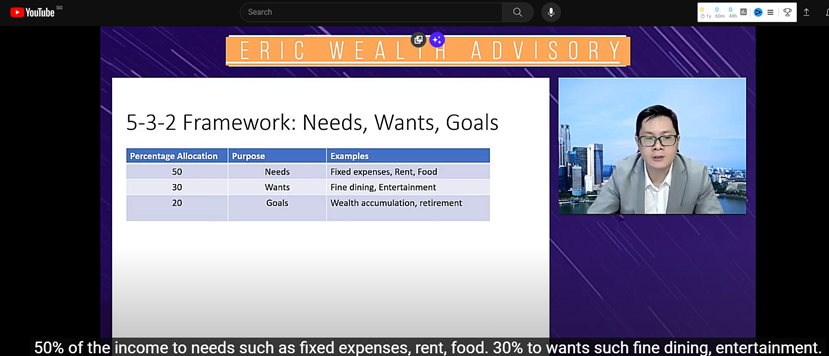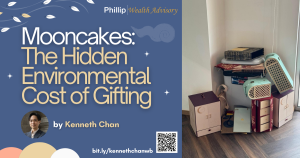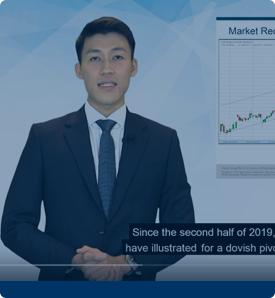A Practitioner’s Perspective: Navigating Market Volatility, Uncertainty and Climate Change June 12, 2024

In today’s dynamic financial landscape, investors face an array of challenges, including information overload, market volatility, high interest rates, climate change concerns, geopolitical conflicts and the ever-present risk of scams. In the rarer cases, global financial storms, such as the S&P 500 posting double-digit percentage drops in 2002, 2008, and 2022, come and go too.
From the past theme of FOMO (fear of missing out) to FOBO (fear of being obsolete), we are living in an ever-fluid situation where values such as peace of mind, balance and success are highly sought after.
In this article, I will outline and share some tried and tested steps to help investors protect and grow their portfolios amidst these challenges. Please note that this information is for general sharing and does not take into account your specific financial situation and thus, does not serve as a recommendation. Investors should consult their brokers or financial advisors or do their own due diligence before doing any form of investing. With that in mind, let us begin.
As investing is dynamic and the only constant is change, it is important to adopt a long-term investment perspective and be disciplined when embarking on any financial goals such as investing for wealth accumulation, retirement, and wealth preservation etc.
Before one starts to build an investment portfolio, the first step in any financial plan, including an investment plan or wealth accumulation plan, is:
1. Start a Personal Budgeting Framework:

The common 5-3-2 framework (refer to above) helps to address the percentage of gross income one can consider allocating to one’s needs, wants and goals. The 5 refers to 50% of one’s income being allocated to essential needs such as fixed expenses, rent, mortgage and food. The 3 refers to 30% allocated to meeting the individual’s wants, such as entertainment, hobbies, fine dining or personal pursuits. The 2, or 20%, refers to the financial goals one aspires to attain, which include protection needs, wealth accumulation, retirement, or even legacy planning.
By having a clear picture of one’s cash flow, it allows one to invest with confidence despite market volatility. This is because the desired allocation of income has already been set aside for savings or investment purposes to meet financial goals.
Next, consider setting up an emergency fund equivalent to a minimum of 6 months or more of living expenses. This fund should be accessible through liquid savings accounts or a money market fund (MMF) investment account. Alternatively, one can invest in 6-month T-bills if short-term liquidity is not needed. This emergency fund will not only help mitigate short-term, sudden unforeseen events such as retrenchment or large medical bills due to accidents, but also provide peace of mind and avoid disruption to the financial goals of wealth accumulation.
2. Address your protection needs before investing:
Ensure adequate coverage for hospitalisation and surgery, sudden death/accidents, total permanent disability (TPD), and severe disability for long-term care (consider CareShield supplements to boost coverage). Additionally, include personal accident coverage depending on your individual financial situation, health risk, and nature of work.
By working with a trusted advisor, you can leverage their expertise and experience to help customise a comprehensive financial plan tailored to your unique financial needs. By transferring such protection risk to insurers, you can better plan and allocate your financial resources towards desired financial goals such as wealth accumulation, retirement, or legacy planning.
3. Diversify Your Portfolio via Asset Allocation:
Harry Markowitz famously said, “Diversification is the only free lunch in investing”. This means that holding a broader range of assets can result in better returns without assuming more risk. By investing in diverse asset classes, one can reduce unsystematic and concentration risk accordingly.
Asset allocation in other words, is assigning funds to various assets such as stocks, bonds, and alternatives to achieve the strategic exposure required for financial goals, time horizon, and risk tolerance. For instance, an investor who invests all their investable capital in US Treasury bonds may unknowingly face geographical, concentration, inflation, reinvestment risk when interest rate changes as their capital is tied to one particular asset.
Hence, instead of allocating 100% of your capital into US treasury bonds, one can consider allocating a certain percentage into other alternatives such as green or ESG investments as an example. These investments consist of companies that focus on sustainable practices, environmentally friendly technologies, and the conservation of natural resources to help reduce the carbon footprint. As they are less correlated to US treasury bonds, the impact on the bonds market is unlikely to spill over to your ESG investments.
By deploying proper asset allocation, one can potentially enhance portfolio returns while reducing unsystematic risk, although market risk will still be present.
4. Start Investing Now:
“Compound interest is the eighth wonder of the world. He who understands it, earns it … he who doesn’t … pays it.” ― Albert Einstein.
Assuming an average return of 7% per annual for a hypothetical asset, let’s compare two investors who stop investing at age 60:
- Investor A, who started investing at age 30 with an initial deposit of S$1,000 and contributes S$1,200 at the end of each year (Annual Regular Savings plan: RSP) for the next 30 years. By age 60, Investor A will have accumulated S$120,965.20.
- Investor B, starts investing at age 50 with an initial deposit of S$1,000 and contributes $1,200 at the end of each year for 10 years. By age 60, Investor B will have accumulated onlyS$18,546.89.
| Hypothetical Asset ( Average 7% return a year) | |||
| Investor profile | Initial Deposit | $1000 | Regular deposit every year | $1200 | Return at 60 |
This demonstrates a difference of $102,418.31 due to Investor A starting 20 years earlier and staying invested. The main takeaway is that by investing early, regularly and consistently, it will put one in a favourable financial position later in life.
In my observations, I notice investors often delay or neglect their financial plans for wealth accumulation or retirement as they either chase temporary fads and themes or procrastinate. Instead of engaging in such emotional behaviour, one could consider adopting a disciplined and systematic approach by setting aside a set amount of funds to invest regularly on a monthly basis. This strategy allows for dollar-cost averaging and can help investors grow their portfolio in the long run. If one is unsure of how to start, they should discuss it with a trusted and reputable financial advisor.
5. Time in the Market vs. Timing the Market:
A persistent warning raised by behavioural finance researchers is that investors too often prove to be their own worst enemies. From my personal experience and observation, many investors tend to bail out, liquidate their entire portfolio, or change strategies midway when the market turns volatile. By adopting short-term strategies related to unrealistic performance chasing or market timing, investors often fail to capture all the benefits that markets can provide over the long term.
When in doubt, do not abandon your investment plan when market volatility increases, instead talk to a financial advisor for advice on the best course of action.
6. No man is an Island: Seek Professional Advice from a Financial Advisor:
Each person may possess different skills, backgrounds, and experiences that may not be related to the financial industry. Therefore, it is advisable to seek help early, as the journey of analysing the market, and constructing an effective investment portfolio can be challenging and time-consuming, if not demanding, for many investors. From curating solutions to custom-fit financial goals to implementation, monitoring and making adjustments for certain market conditions, it is a taxing and daunting task for non-practitioners or working parents whose time is stretched between work, family and rest.
The psychological stress of handling a multi-million-dollar investment portfolio on your own versus a small one-thousand-dollar investment portfolio is vastly different, if not mind-boggling, for many. This is where the rubber meets the road. An experienced advisor can not only help you map out your financial goals but also mitigate detrimental behavioural biases such as overconfidence, loss aversion, anchoring biases, or other nuances an investor may unknowingly have.
Conclusion:
Navigating today’s complex financial landscape first requires one to have a holistic financial plan that addresses short, medium and long-term needs. This plan should cover areas such as protection, liquidity and wealth accumulation goals, all tailored to one’s financial situation, time horizon and risk appetite.
Secondly, one would also need to craft a resilient investment strategy that can weather these financial storms, which requires a long term, committed and disciplined approach. These two steps, when done alone can be quite challenging.
Hence, leveraging the help of a trusted financial advisor who shares your values is essential for building a resilient and adaptive investment strategy that stands the test of time. If you resonate with values such as peace of mind, balance and success, feel free to reach out to me @ https://bit.ly/TTPericoh/
Contributor:

Eric Oh
Financial Services Manager
Phillip Securities Pte Ltd (A member of PhillipCapital)
https://bit.ly/TTPericoh
Disclaimer
These commentaries are intended for general circulation. It does not have regard to the specific investment objectives, financial situation and particular needs of any person who may receive this document. Accordingly, no warranty whatsoever is given and no liability whatsoever is accepted for any loss arising whether directly or indirectly as a result of any person acting based on this information. Opinions expressed in these commentaries are subject to change without notice. Investments are subject to investment risks including the possible loss of the principal amount invested. The value of the units and the income from them may fall as well as rise. Past performance figures as well as any projection or forecast used in these commentaries are not necessarily indicative of future or likely performance. Phillip Securities Pte Ltd (PSPL), its directors, connected persons or employees may from time to time have an interest in the financial instruments mentioned in these commentaries. Investors may wish to seek advice from a financial adviser before investing. In the event that investors choose not to seek advice from a financial adviser, they should consider whether the investment is suitable for them.
The information contained in these commentaries has been obtained from public sources which PSPL has no reason to believe are unreliable and any analysis, forecasts, projections, expectations and opinions (collectively the “Research”) contained in these commentaries are based on such information and are expressions of belief only. PSPL has not verified this information and no representation or warranty, express or implied, is made that such information or Research is accurate, complete or verified or should be relied upon as such. Any such information or Research contained in these commentaries are subject to change, and PSPL shall not have any responsibility to maintain the information or Research made available or to supply any corrections, updates or releases in connection therewith. In no event will PSPL be liable for any special, indirect, incidental or consequential damages which may be incurred from the use of the information or Research made available, even if it has been advised of the possibility of such damages. The companies and their employees mentioned in these commentaries cannot be held liable for any errors, inaccuracies and/or omissions howsoever caused. Any opinion or advice herein is made on a general basis and is subject to change without notice. The information provided in these commentaries may contain optimistic statements regarding future events or future financial performance of countries, markets or companies. You must make your own financial assessment of the relevance, accuracy and adequacy of the information provided in these commentaries.
Views and any strategies described in these commentaries may not be suitable for all investors. Opinions expressed herein may differ from the opinions expressed by other units of PSPL or its connected persons and associates. Any reference to or discussion of investment products or commodities in these commentaries is purely for illustrative purposes only and must not be construed as a recommendation, an offer or solicitation for the subscription, purchase or sale of the investment products or commodities mentioned.
About the author
Eric Oh
Financial Services Manager
Eric Oh is a Senior Broker and Financial Services Manager at Phillip Securities. He began investing in 2001 and launched his professional career as a Proprietary Trader with Phillip Securities, managing multi-million-dollar portfolios. In his role, he not only advises clients on managing their wealth, but also implements strategies for wealth accumulation, protection, and retirement planning. Many of his clients have traded with him for over a decade, entrusting substantial sums of money to his management. Eric enjoys working with committed professionals to build lasting, empowering, and beneficial relationships.

 Mooncakes: The Hidden Environmental Cost of Gifting
Mooncakes: The Hidden Environmental Cost of Gifting  Why Idle Cash Attracts Scammers & How to Beat Them
Why Idle Cash Attracts Scammers & How to Beat Them  Factor-Based (Smart-Beta) ETFs: How They Work, Selection Criteria, and Practical Uses for Singapore Investors
Factor-Based (Smart-Beta) ETFs: How They Work, Selection Criteria, and Practical Uses for Singapore Investors  What is an Active ETF?
What is an Active ETF? 






